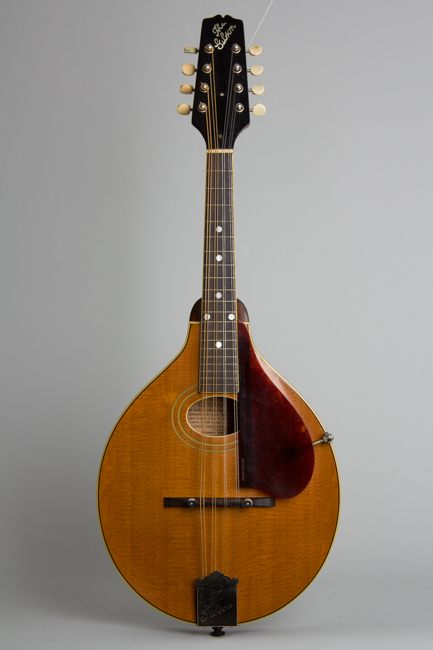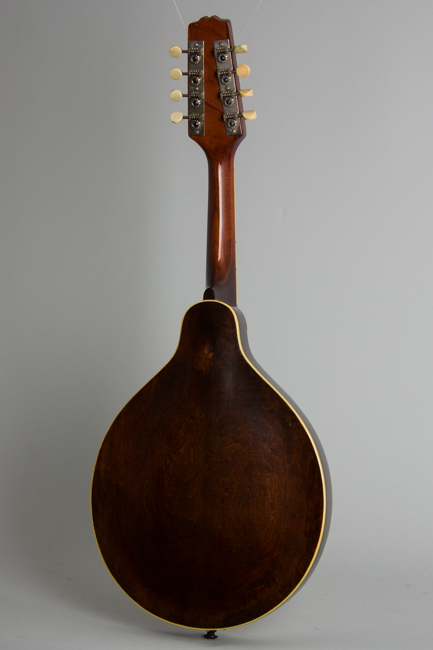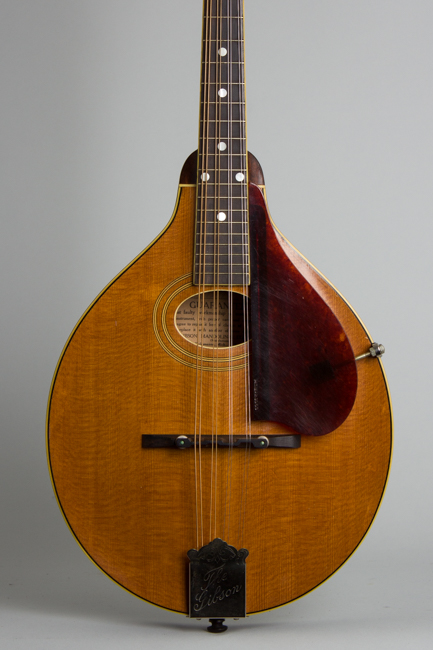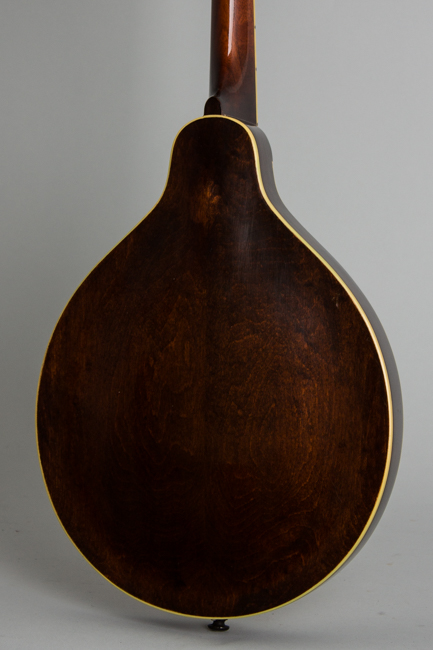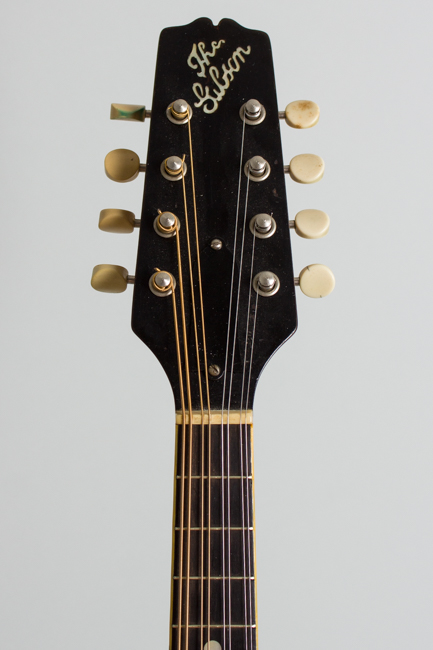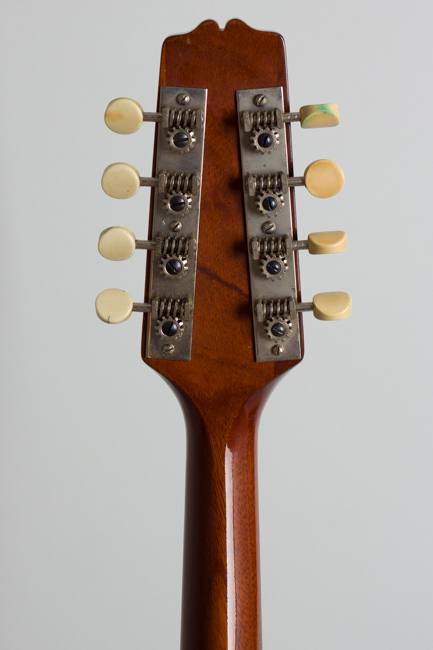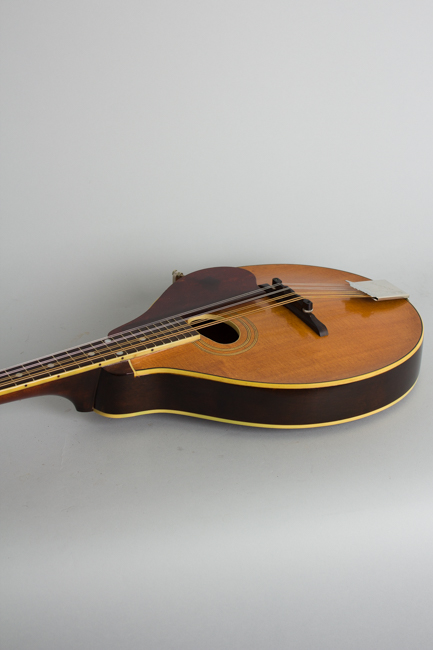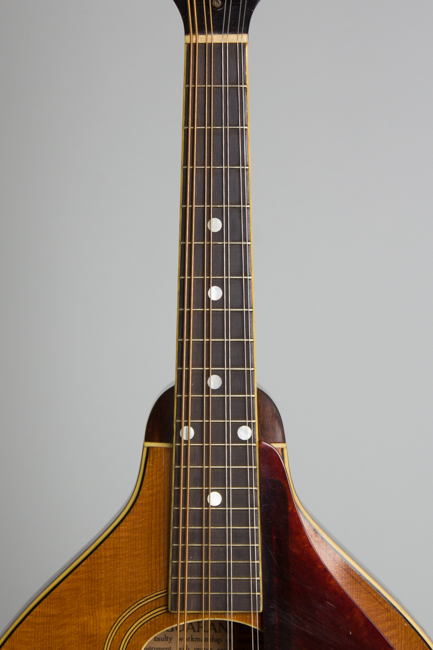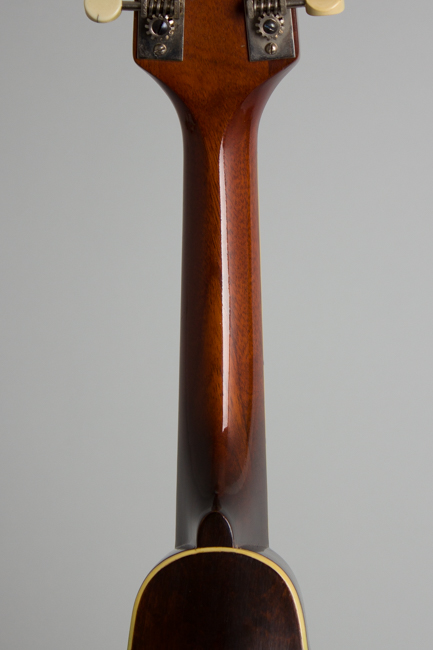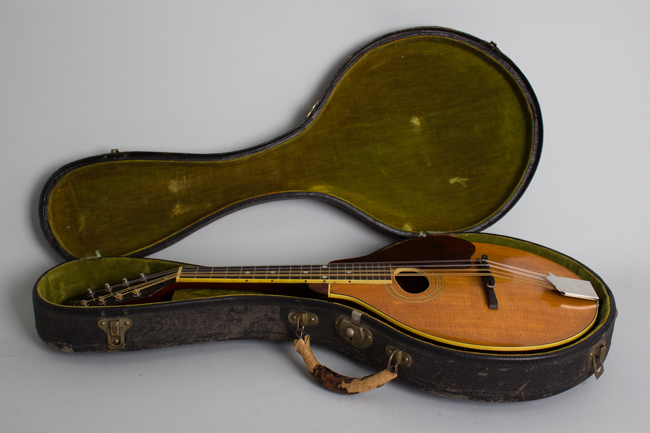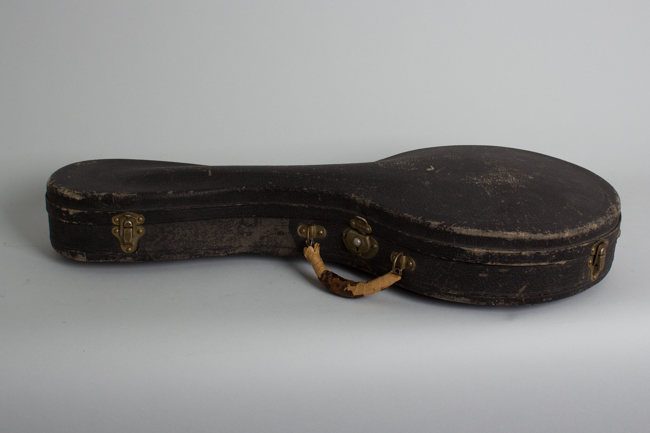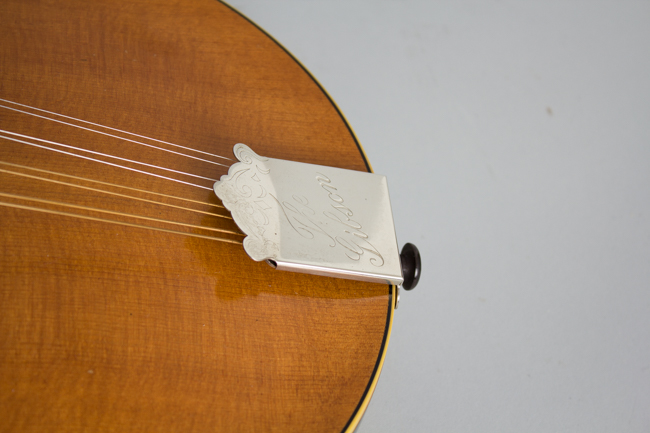Gibson A-2 Snakehead Carved Top Mandolin (1923)
This item has been sold.
Item # 11013
Prices subject to change without notice.
Gibson A-2 Snakehead Model Carved Top Mandolin (1923), made in Kalamazoo, Michigan, serial # 81291, natural top, dark back and sides finish, birch back and sides, spruce top; mahogany neck with ebony fingerboard, original black hard shell case.
this is a really great-playing and sounding original Style A-2 mandolin with an interesting Gibson tale, having been part of a batch fabricated at the end of 1923, the peak of the "Loar Era", but not labelled and sold until 1927. Such dating discrepancies are not uncommon for this period, as Gibson was experiencing a drastic drop in mandolin sales but even so this is an unusually long gap. The Factory Order Number (11995) stamped on the neck block belongs to one of several batches of mandolins designated as A-2Z models started right at the end of 1923. The serial number on the label under the soundhole dates to early-mid 1927; this was affixed when the instrument was ready to be shipped out and suggests this one sat unfinished at the Gibson factory for over 3 years!
Despite this gap this is a distinctive Loar-era "Snakehead" through and through. These have become ever more sought-after by discerning players over the last decades for their unmatched sound and playability. Lloyd Loar's tenure as acoustic engineer at Gibson has become so mythical that sometimes separating fact from fiction is difficult. The mandolin family instruments made during this period are the most perfectly realized in Gibson's history, showing the influence of a master player on design and execution. Other Gibson employees (especially Thaddeus McHugh and Lewis A. Williams) actually engineered many of the technical improvements of the early 1920s and all Gibson mandolin family instruments were refined at the time.
Generally these "snakeheads" are considered the best-sounding round hole A-style mandolins ever made, and this one certainly bears this out. The A-2 was a midline mandolin listing at $70 (plus case) making it fairly rare compared to the less expensive Style A and A-Junior models, sold mostly to students. This one was fabricated just after the A-2 model had been whimsically re-named the "A-2z" and made just slightly fancier. Quite a few batches of A-2z's appear in factory order numbers at the end of 1923, apparently they took a long time to sell off and by the time this one was finished out were back to using the designation A-2. that model was last listed for sale in early 1927, so this is likely one of the last A-2's to be cleared out of factory stock.
It features the new-in-1923 "snakehead" headstock, thinner neck, adjustable truss rod and height adjustable bridge that all characterize the improved Loar era instruments. The original finish is the clear lacquer Gibson was using around 1927; this instrument likely sat "in the white' unfinished while waiting to be fitted out. The top is triple bound (an A-2Z specification) back and fingerboard are single-bound. The soundhole ring lacks the celluloid center inset that is also part of the A-2Z specification, hewing to the plainer A-2 spec. The elevated pickguard is fully intact and is held with the screw bracket.
This is a fine example of Gibson's craftsmanship just before the company's focus shifted to banjos and then guitars. These "Snakehead" instruments are revered for their unmatched tone and projection and have all the most advanced features of the era including the adjustable truss rod, raised adjustable bridge, and slim neck profile. This is a wonderful example of the Loar-inspired improvements that made these the best instruments of their type, then and arguably now.
Overall length is 25 7/8 in. (65.7 cm.), 10 1/16 in. (25.6 cm.) width, and 1 13/16 in. (4.6 cm.) in depth, measured at side of rim. Scale length is 13 7/8 in. (352 mm.). Width of nut is 1 1/8 in. (29 mm.).
This is a truly superb example of this rare and interesting Gibson "A" model, showing very light play time but no major wear or repair over the last 95 years. There are no visible repairs. A small area of finish on the back has a slight wear-through, but apart from this the original thin lacquer has only light checking and very minor scuffs and dings. All hardware is original, complete and in excellent condition. The original frets have very little wear. Really this mandolin shows not too much play time for nearly a century on earth, after so many decades they really do not come too much better than this. It plays beautifully with a truly superior sound and includes a nice original HSC, a bit more worn than the enclosed instrument. Excellent + Condition.
this is a really great-playing and sounding original Style A-2 mandolin with an interesting Gibson tale, having been part of a batch fabricated at the end of 1923, the peak of the "Loar Era", but not labelled and sold until 1927. Such dating discrepancies are not uncommon for this period, as Gibson was experiencing a drastic drop in mandolin sales but even so this is an unusually long gap. The Factory Order Number (11995) stamped on the neck block belongs to one of several batches of mandolins designated as A-2Z models started right at the end of 1923. The serial number on the label under the soundhole dates to early-mid 1927; this was affixed when the instrument was ready to be shipped out and suggests this one sat unfinished at the Gibson factory for over 3 years!
Despite this gap this is a distinctive Loar-era "Snakehead" through and through. These have become ever more sought-after by discerning players over the last decades for their unmatched sound and playability. Lloyd Loar's tenure as acoustic engineer at Gibson has become so mythical that sometimes separating fact from fiction is difficult. The mandolin family instruments made during this period are the most perfectly realized in Gibson's history, showing the influence of a master player on design and execution. Other Gibson employees (especially Thaddeus McHugh and Lewis A. Williams) actually engineered many of the technical improvements of the early 1920s and all Gibson mandolin family instruments were refined at the time.
Generally these "snakeheads" are considered the best-sounding round hole A-style mandolins ever made, and this one certainly bears this out. The A-2 was a midline mandolin listing at $70 (plus case) making it fairly rare compared to the less expensive Style A and A-Junior models, sold mostly to students. This one was fabricated just after the A-2 model had been whimsically re-named the "A-2z" and made just slightly fancier. Quite a few batches of A-2z's appear in factory order numbers at the end of 1923, apparently they took a long time to sell off and by the time this one was finished out were back to using the designation A-2. that model was last listed for sale in early 1927, so this is likely one of the last A-2's to be cleared out of factory stock.
It features the new-in-1923 "snakehead" headstock, thinner neck, adjustable truss rod and height adjustable bridge that all characterize the improved Loar era instruments. The original finish is the clear lacquer Gibson was using around 1927; this instrument likely sat "in the white' unfinished while waiting to be fitted out. The top is triple bound (an A-2Z specification) back and fingerboard are single-bound. The soundhole ring lacks the celluloid center inset that is also part of the A-2Z specification, hewing to the plainer A-2 spec. The elevated pickguard is fully intact and is held with the screw bracket.
This is a fine example of Gibson's craftsmanship just before the company's focus shifted to banjos and then guitars. These "Snakehead" instruments are revered for their unmatched tone and projection and have all the most advanced features of the era including the adjustable truss rod, raised adjustable bridge, and slim neck profile. This is a wonderful example of the Loar-inspired improvements that made these the best instruments of their type, then and arguably now.
Overall length is 25 7/8 in. (65.7 cm.), 10 1/16 in. (25.6 cm.) width, and 1 13/16 in. (4.6 cm.) in depth, measured at side of rim. Scale length is 13 7/8 in. (352 mm.). Width of nut is 1 1/8 in. (29 mm.).
This is a truly superb example of this rare and interesting Gibson "A" model, showing very light play time but no major wear or repair over the last 95 years. There are no visible repairs. A small area of finish on the back has a slight wear-through, but apart from this the original thin lacquer has only light checking and very minor scuffs and dings. All hardware is original, complete and in excellent condition. The original frets have very little wear. Really this mandolin shows not too much play time for nearly a century on earth, after so many decades they really do not come too much better than this. It plays beautifully with a truly superior sound and includes a nice original HSC, a bit more worn than the enclosed instrument. Excellent + Condition.
